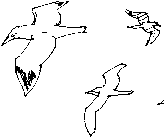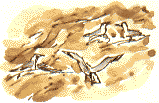

Cliff-hangerSaturday 24th June 2000
IT'S EASY to take a close look at wild flowers alongside the paths behind the pavilion at Scarborough. The slope here is so steep that what would normally be at your feet is at eye-level. We spot a single Pyramidal Orchid on a grassy banking. There are a few patches of Quaking Grass. The flowerheads hang from wire-thin stems like little Chinese lanterns. Such patches are a tiny remnant of the wildflower-rich turf that must have stretched for thousands of acres across the Yorkshire Wolds before 'improvements' in agriculture. How long can wildlife keep clinging in these nooks and corners? The Kittiwakes seem to be doing well; there's a thriving colony on the cliff ledges below the site of the Roman signal station on the promontory where Scarborough Castle stands. It's as lively and noisy as the popular area of fish and chips shops, pubs and souvenir shops around the fishing harbour a few hundred yards away. Seaside shopping After walking along Marine Drive, we cut back across the town and for
20 minutes join the Saturday shoppers in the pedestrianised centre of
the town. What I like about Scarborough as a shopping centre is that, when you've had enough of the crowds, you can slip down a side-street and within as little as five
minutes you'll find a view of the open sea stretching out before you.
After walking along Marine Drive, we cut back across the town and for
20 minutes join the Saturday shoppers in the pedestrianised centre of
the town. What I like about Scarborough as a shopping centre is that, when you've had enough of the crowds, you can slip down a side-street and within as little as five
minutes you'll find a view of the open sea stretching out before you.SleightsWe take a walk through a small wood established on what was, 18 years ago, a steep and scrubby meadow. Roe Deer, we're told, are regular visitors. They have browsed back the small areas of Hazel that were planted as coppice. So, as an experiment, the coppice now consists of small pollarded hazels. The deer don't seem to bother to nibble anything that isn't in easy reach, so if a tree can be protected in a plastic tube until it is about three feet high it has a chance of thriving. a small wood established on what was, 18 years ago, a steep and scrubby meadow. Roe Deer, we're told, are regular visitors. They have browsed back the small areas of Hazel that were planted as coppice. So, as an experiment, the coppice now consists of small pollarded hazels. The deer don't seem to bother to nibble anything that isn't in easy reach, so if a tree can be protected in a plastic tube until it is about three feet high it has a chance of thriving.Grey Squirrels have killed several young Oaks. A Greater Spotted Woodpecker flies to a fruit tree that has grey lichen on its branches. The attraction seems to be the white woolly secretions on the knobbly growths all over the trunk. I suspect these might be the result of an infestation by Scale insects, or something similar.
|